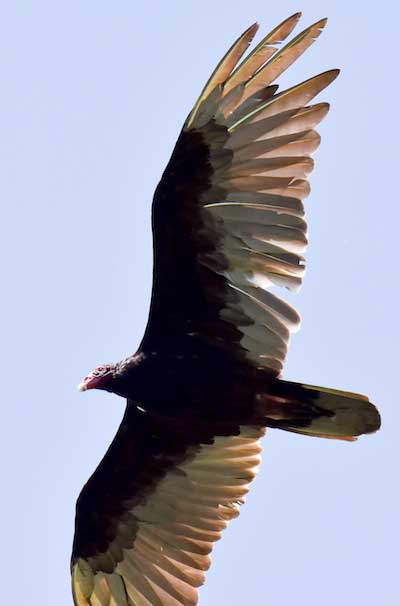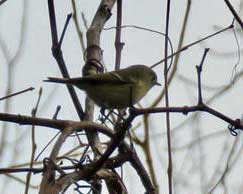13,000 birds counted in annual event at Oak Orchard Swamp, including 20 bald eagles
Turkey Vultures were an unusual sight for the bird count
By Celeste Morien, Count Compiler

Photo by Celeste Morien: This Turkey Vulture is shown in the Oak Orchard Swamps, but not on the Christmas Bird Count day of Dec. 27.
SHELBY – On December 27, 21 volunteers participated in the 52nd annual Oak Orchard Swamp Christmas Bird Count.
The National Audubon Society, in collaboration with the U.S. Fish and Wildlife Service, sponsor Christmas Bird Counts annually throughout the country and beyond in the Americas. Each count consists of a tally of all birds seen within a 15-mile diameter circle on one day that falls within a 15-day period at the end of December and the beginning of January. Audubon Christmas Counts have been taking place for 119 years and provide valuable information on the range expansion or narrowing of wintering bird populations.
The center for the Oak Orchard count is the point at which the Genesee-Orleans County line crosses Route 63. The 15-mile diameter circle includes the Iroquois National Wildlife Refuge, Oak Orchard and Tonawanda State Wildlife Management Areas, the Tonawanda Native American Reservation, the townships of Alabama and Shelby, the villages of Indian Falls, Medina and Wolcottsville and portions of Middleport and Oakfield.
Count hours were warm and mild, with a low of 39F and high of 57F, both above the average daily temperature for the date of 34F. Both morning and afternoon were essentially precipitation free.
Our observers were afield in 14 parties from 6:30 a.m. until 5:50 p.m., and in 322.5 total hours covered 35 miles on foot and 504 miles by car! One observer counted birds at home feeders. Participants also clocked 4 nocturnal hours and 37 miles searching for owls. In total, these observers tallied 62 species. 13,248 individual birds were counted, which is an improvement over last year. Despite this year’s open water, because of a hard freeze in November most waterfowl had left the region by count day.
For the second year in a row, counters commented on difficulty finding sparrow species including low numbers of wintering Dark-eyed Juncos, American Tree Sparrows and other common sparrows. With the lack of snow, participants reported that birds were difficult to see in fields and were not present at the roadsides.
No irruptive species (those that visit in winter from the boreal forest when cone crops there are low) were noted this year, except for a few Red-breasted Nuthatches. Two notable highest counts ever were of 20 Bald Eagles (!) and 493 Herring Gulls. Turkey Vulture was the one “new to the count” species this year.

This female Ruby-crowned Kinglet was photographed by Jennifer Rycenga of San Mateo, CA. It was seen on Waterworks Road.
A Ruby-crowned Kinglet, a Hermit Thrush, and a Yellow-rumped Warbler were all found lingering in the count area by our sharp-eyed participants. Count week birds seen in the three days before or after the count date were Tundra Swan, Hooded Merganser, Short-eared Owl, Savannah Sparrow and Turkey Vulture.
The Friends of Iroquois, Inc. sponsored evening refreshments at the refuge. The INWR Staff contribute time and effort in covering the refuge areas. The NYS DEC staff volunteered to report birds while on duty and conducted their winter raptor survey on count afternoon. Many thanks go out to everyone who participated! We rely on volunteer support every year to continue this important tradition.
A list of species follows:
• Canada Goose, 4,447; European Starling, 4,105; House Sparrow, 690; Rock Pigeon (Feral Pigeon), 499; Herring Gull, 493; Mallard, 327;
• Ring-billed Gull, 307; Black-capped Chickadee; 287; American Crow, 270; Mourning Dove, 173; Red-winged Blackbird, 151; American Tree Sparrow, 142;
• Dark-eyed Junco, 140; Brown-headed Cowbird, 139; American Goldfinch, 127; Northern Cardinal, 109; Blue Jay, 102; Cedar Waxwing, 85; Downy Woodpecker, 83;
• White-Breasted Nuthatch, 73; House Finch, 62; Eastern Bluebird, 48; Wild Turkey, 48; Red-tailed Hawk, 47; Red-bellied Woodpecker, 46; American Black Duck, 31;
• Hairy Woodpecker, 30; Northern Flicker, 29; American Robin, 22; White-throated Sparrow, 21; Bald Eagle, 20; Tufted Titmouse, 17; Horned Lark, 10; Song Sparrow, 9;
• Brown Creeper, 9; Pileated Woodpecker, 8; Golden-crowned Kinglet, 5; Eastern Screech Owl, 5; Cooper’s Hawk, 5; Northern Harrier, 4; Red-breasted Nuthatch, 3; American Kestral, 3; Sharp-shinned Hawk, 3; Great Blue Heron, 3; Ring-necked Pheasant, 3;
• Carolina Wren, 2; Common Raven, 2; Merlin, 2; Great Horned Owl, 2; Common Merganser, 2;
• Yellow-Romped Warbler, 1; Hermit Thrush, 1; Ruby-crowned Kinglet, 1; Northern Shrike, 1; and Barred Owl, 1.









































































